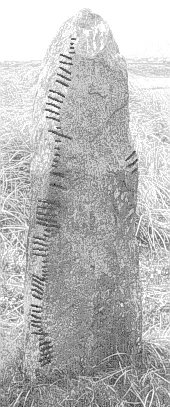For the location and discovery, cf. {148}. This stone alone remained at Ballinrannig, "its great size and weight having prevented its removal" (Brash, OIM 212).
Size according to Brash, OIM 212 (measured by J. Brenan): 8' x 1'10" x 6"
Size according to Macalister, CIIC: 5'8" x 1'8" x 0'7"
Published illustrations:
- Brash, OIM pl. XXXIV, no. 7 (draft).
- Macalister, Epig. 2,21 (outline of inscription);
- Macalister, CIIC 1, 150 (draft).
Reading Windele 1848 (quoted by Brash, OIM 212):
CONA MAQQI CORBBU
This copy "differs slightly from that of 1838" which was prepared when Windele first visited the site.
Reading Brash, OIM 212 (7.) (on the basis of a transcript made by J. Brenan in summer 1871):
Left:
CONAMAQQICORBBIMAQQI
"(Stone of) CON THE SON OF CORBB THE SON OF"
On the opposite angle, the letters CU or CO can be read according to Brenan's copy. "Mr. Windele's copy is substantially the same as the above", only the last letter is imperfect. - Con "is a recognized name, as, Con-Cead-Cathach. Gaulish form, Connius .. Grut. 776,1. Conatius .. Stein. 2022. For illustrations of Corb, see Laharan, No. 2" {244: Rockfield}.
Readings quoted by Ferguson, OI 43 (63: "Transcripts by various hands"):
CUNAS MAQQI CORLI MAQQI--
and
CONA MAQQI CORBBI MAQQI --
[Ferguson never saw the stone personally: OI, 42.]
The second proposal makes more sense than the first one because of the name CORB which means "bad, wicked"; a motivation for this kind of denomination is given under Ballinrannig IV {151}.
Reading Barry, JRSAI 1895, 352 (quoted by Macalister, Epig. 1, 40):
CUNA MAQQI CORBBI MAQQ(i MUCOI DOVINI?)AS
leftЄtop©right
омдкйвпвононедомгтсззедпвононгжжжжжжжжжжвки
CUNAMAQQICORBBIMAQQ[i mucoi ....]AS
Cp. Ballintaggart {162}; the present stone proves that this has to be read as CUNA MAQQI AVI CORBBI, i.e. `of Con, great-grandson of Corb'. Possibly this CUNA was the grand-father of the CUNA mentioned on the Ballintaggart stone. The tribal name was restored as mucoi Dovinias by [E.] Barry, but "there is not enough room for the name". Besides, we should have to expect some rests of the N before the S. Instead, all missing characters seem to have been on the H-surface. The mucoi-formula was possibly destroyed here as elsewhere because of "intertribal jealousies". The "tribe of Duben" bearing the name Dovinia, "being strong in their own territory, were presumably able to protect their tribesmen's tombstones" so that the name was preserved often enough. - The reading is further discussed in connection with Ballintaggart no. 8 {162} in Epig. 1, 40 where Macalister states that all former readings "fairly well agreed on Co/una maqqi Corbbi so that "in any case we must here have Cuna maqqi Corbbi, and not Cunamaqqi Corbbi [i.e., of Conmac, son of Corb]".
CUNAMAQQI CORBBI MAQQ[I MUCCOI DOVVINIA]S
"There is room enough for the restoration suggested, which local analogy makes probable; but the destroyer has been too thorough to leave a single trace of the writing to guide us." In Ballintaggart {162}, a "namesake and most likely a relative of the owner" of the present monument is mentioned, named CUNAMAQQI AVI CORBBI; possibly, the intended reading of this was CUNAMAQQI MAQQI CORBBI, the second MAQQI having been omitted, "through inadvertence, or laziness, or to economise the space" available; "or perhaps to guard against ambiguity, as the reader might mistake his intention and understand it as CUNA MAQQI MAQQI-CORBBI".
CUNAMAQQI CORBBI MAQQ[I MUCOI 7/8]S
The restitution of the mucoi-formula is probably right but the one of Dov(v)inia remains a mere hypothesis. - All the stones from this site show archaic linguistic traits.
Reading Sheehy (Dingle, 52):
CUNAMAQQI CORBBI MAQQI MUCCOI DOVVINIAS
"All the words are in good condition, although the last name has been destroyed except for the final S, probably because of pagan associations."
Reading Gippert (1978/1981):
 Dexter angle up - [top -
Dexter angle up - [top -  sinister angle down ??]:
sinister angle down ??]:
CUNAMAQQI CORBBI MAQQ[ | | ]( )
омдкйвпвононедомгтсззедпвононед[ | | ](й)
ллллвввзззззвпвлллллжлллллвввввллллввпппппззвввввпвлллллжлллллввввв[ | | ](ззз)
There is no trace whatsoever of the characters as restored by Barry and, accordingly, Macalister in the CIIC except for three strokes which might be regarded as the remainder of a V or an S if the direction of reading is sinister-down.
Additional literature:
- JRSAI 1895, 352 (E. Barry)
- For further references cf. {148}.
Last changes of this record: 27.04.97
Copyright Jost Gippert, Frankfurt a/M 1996. No parts of this document may be republished in any form without prior permission by the copyright holder.  Dexter angle up - [top -
Dexter angle up - [top -  sinister angle down ??]:
sinister angle down ??]:



